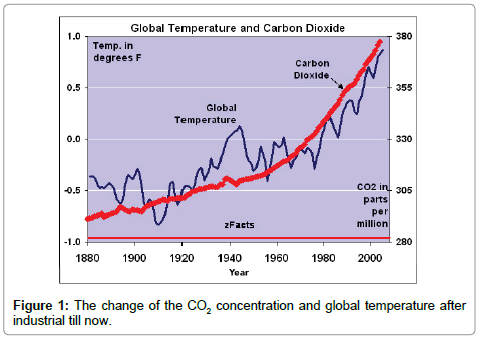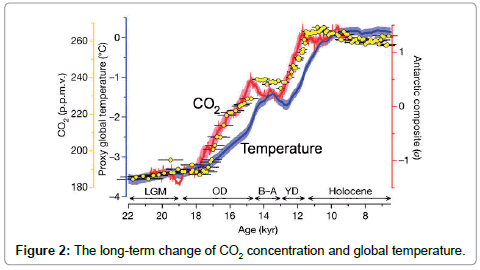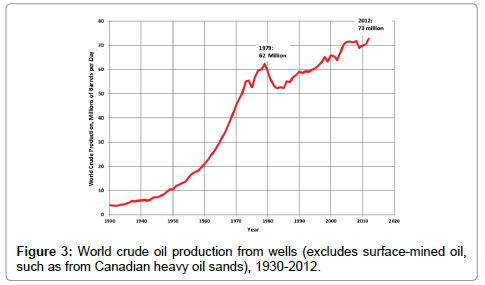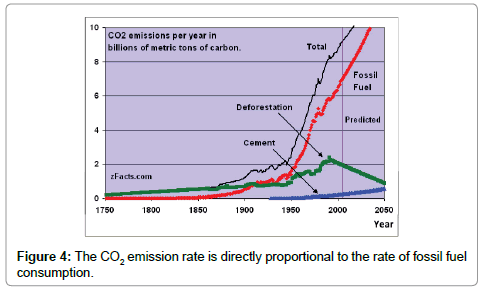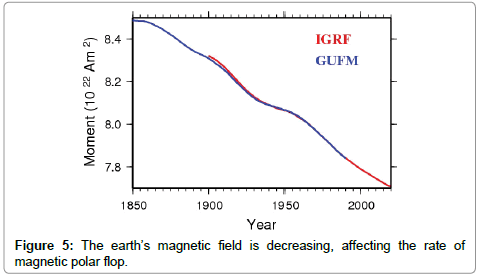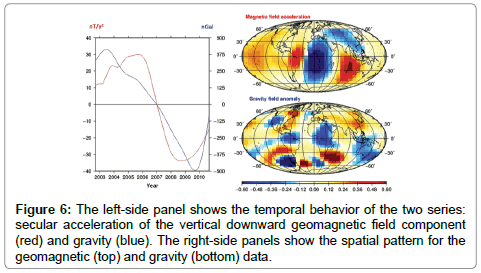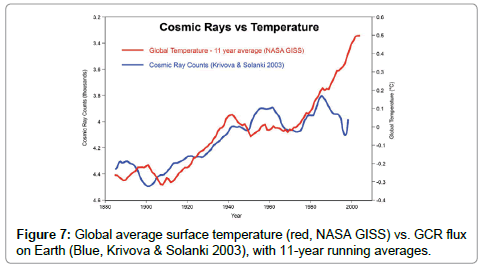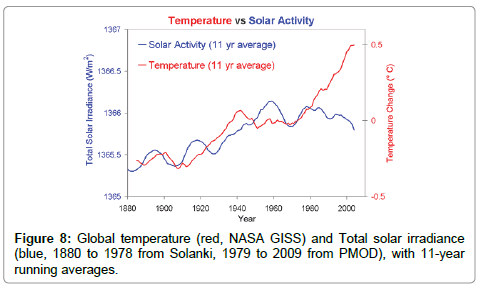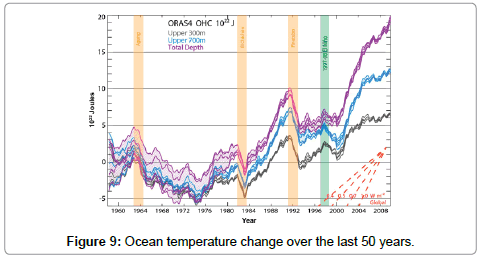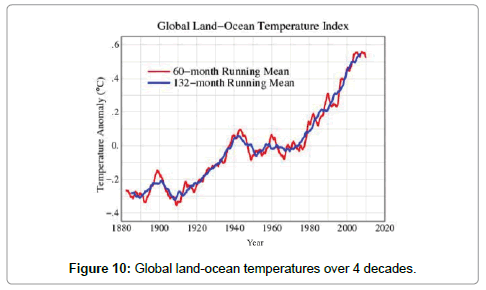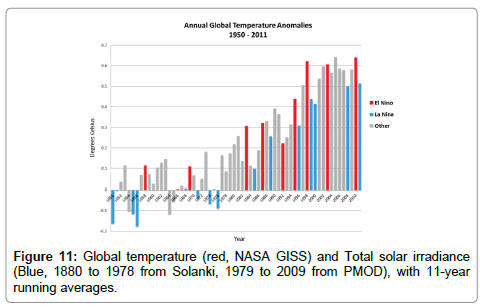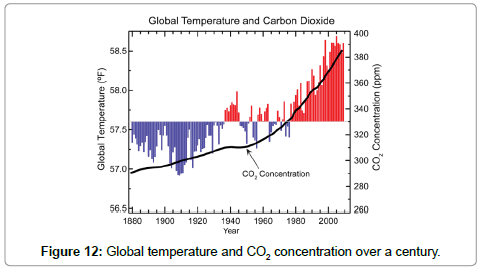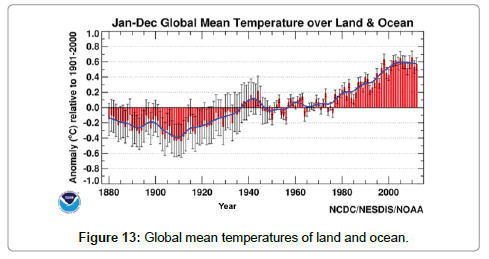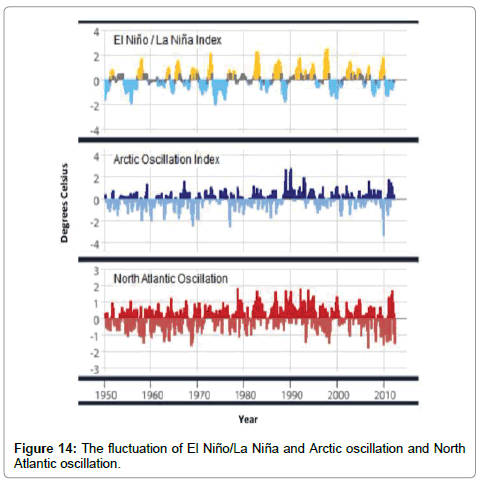Review on Recent Global Warming based on New Geophysical Evidence
Received: 30-Jul-2017 / Accepted Date: 12-Oct-2017 / Published Date: 17-Oct-2017 DOI: 10.4172/2157-7617.1000415
Abstract
Even if anthropogenic global warming is based on so firm an academic ground, it cannot scientifically explain all problems coming from pan-environment of the earth. Especially, the theory presumes that the man-made greenhouse gases such as CO2 and methane gas which compose trace amount in the earth’s atmosphere, let alone the most serious, dominant green- house gas such as water vapor. No matter what effect they have on the earth’s ecological system and climate, the immense ocean’s heat capacity or energy reserve will not wholly depend on their warming effects in the neglect of the sun, the principal energy source of the earth for the last 4.6billion years. In this regard, we geared our research into some other geophysical factors well compensating for the solar activity and the great oceans on the basis of abiotic oil produced in mantle-core. With the recently acquired new geophysical information, we could deduce a theory that the slowly weakening geomagnetic field may have resulted from the boundless consumption of fossil fuels, and thus explain not only that the exhaustion of fossil fuels is highly connected with the change of earth’s magnetic field, which in turn causes decaying earth’s orbital, but also that the recent theoretical predicament that in the period of industrial boom from 1940s to 1970s, during which the concentration of CO2 remarkably increased while the global temperature unexpectedly went down.
Keywords: Global warming; Greenhouse effect; Global climate change; Arctic cycle; El-Niño/La-Niña, Decaying orbital; Earth’s magnetic field; Abiotic oil; Mantle-core convection
Introduction
Since the Kyoto Protocol, there have been ceaseless debates over the real cause of the global warming between the maverick scientists who claim the natural cause, including solar activity, the change of earth’s axis of rotation, its orbital around the sun or the effect of volcanic eruption, whereas main stream scientists sufficiently funded by the United Nations, local governments or gigantic incorporations contend the anthropogenic global warming due to greenhouse gases like CO2 and methane gas especially produced by human activity. Unfortunately, despite the present dominant prevalence of the anthropogenic global warming (AGW) due to man-made greenhouse gases, substantial amounts of newly found evidence never appear to give the final judgments as to which theory is right or wrong, since both sides have self-justified plausible theories and evidence with which to persuade the confused public into their sides. At the center of this chaos, where there is no critically convincing evidence, we propose one theory to explain recent inconvenient global warming based on both well-accepted evidence and newly found information so far. Especially, we emphasized the role of the abiotically synthesized oils and gas in the region of mantle-core boundary. Serious experimental results and discoveries on this process gains propulsion from science community these days are thus properly dealt with in the stream of the whole presentation.
Method
From the various new recent evidence accumulated by scientifically credible books, journals and internet sources, comprehensive scientific explanations regarding the global warming phenomena has been made in the paper. All conjectures and theories are supported by officially publicized scientific materials. Each resource is well offered in the reference section.
Results and Discussion
Earth orbit is changing
In Figure 1, it is obvious that in the period of Postwar Industrial Boom from 1940 through 1970, during which the global temperature dropped while CO2 concentration in the atmosphere had increased. This goes directly against the theory of anthropogenic global warming in the decadal scale. To explain this, we have done a research on this mismatch by inserting the plausibly compensating natural cause into the equation of the global warming. The high temperature in the earth’s outer core is closely interconnected with earth’s magnetic field [1], gravitational fields [2,3], earth’s rotation [4] and even earth’s orbit, which is highly relevant to ocean’s activity [5,6]. The earth’s fuel system was believed to be the extremely hot solid inner core, yet there has been a new theory that crude oil and natural gas wells in the lower mantle supply heat energy to the liquid outer core that generates the earth’s magnetic field. Chris Marone, the Penn State professor of geosciences, posits that the four heating sources keeping the inside of the earth constantly hot: Thermal energy of initially hot planet, Gravitational (buoyancy) energy, Latent heat, Energy released by decay of radioactive elements. Yet, the vast majority of the heat in Earth's interior—up to 90 percent—is fueled by the decaying of radioactive isotopes like Potassium 40, Uranium 238, 235, and Thorium 232 contained within the mantle [7]. However, no radiation has ever been detected during, or after volcanic eruptions except only crude oil, and natural gas byproducts, including carbon dioxide, sulfur dioxide, and carbon monoxide gases which certainly originate from the lower mantle, and outer core region of this planet. Recently, however, for the first time, it has been found that ethane and heavier hydrocarbons can be synthesized under the high pressure-temperature conditions of the upper mantle —the layer of earth under the crust and on top of the core [8]. More surprisingly, enough anomalies have been accumulated to seriously challenge the idea that oil and gas are byproducts of ancient animal life. Rather than result from decaying organic matter, as known so far, oil and gas originated from the earth's core [9]. As the earth accreted long ago, it had collected abundant carbonaceous material from carbonaceous chondrites and comets containing organic sludge. Under the heat and pressure available at these great depths, oil and gas were produced abiogenetically in immense quantity and driven outwards to where they were trapped in rock reservoirs. Recently strong evidence for abiotic origin of oil and gas has been found to support this hypothesis. Proskurowski and his team found hydrocarbons containing carbon-13 isotopes that appeared to be formed from the mantle of the Earth, rather than from biological material settled on the ocean floor. Carbon 13 is the carbon isotope that scientists associate with abiotic origin compared to Carbon 12 that scientists typically associate with biological origin [10]. To give more evidence to this discovery, Belonoshko et al. established a great model to clarify the synthesis of heavy hydrocarbons at the core-mantle boundary [11]. More surprisingly, Bin Chena et al. at University of Michigan, from new seismic experiment, has recently made a remarkable model revealing that heavy portion of carbons are hidden in the inner core of the earth and the source of these carbons are not yet determined. Alfèa et al. [12], Philippe Cardin et al [13], and Keke Zhang et al. [14], already established thermodynamic models relevant to this phenomenon long ago. These new pieces of discovery and experiments with pretend to weigh the theory that abiotically produced carbon based oils and gas comprise the other serious energy source for the hot outer core. This means that right from the beginning of the earth, along with minor other sources of energy, crude oil, and natural gas have fueled the earth’s core, generating and maintaining its magnetic field. Unsustainable human activity of extracting gas and oil compromised this earth’s fuel system, diminishing the fuel to the earth’s outer core by releasing pressure out of these oil and gas wells. Under normal conditions, the outer core stays at a constant temperature between 5000 to 7000 degrees Celsius, with the pressure in the outer core, lower mantle, and in oil wells staying at tens of thousands of pounds per square inch. The pressure in an oil well forces the oil and natural gas into the outer core, but they are ignited long before they reach the outer core, and thus end up entering the lower mantle and outer core as flames, heat, and pressure. The oxygen in the crude oil makes this combustion possible in the lower mantle and outer core [12-15]. Eventually, the earth’s core lacks the fuel to sustain this process, slowly cooling its outer core down. It has already been reported that Earth's magnetic field has recently been weakening 10 times faster [16,17]. New findings from a team including Carnegie's Ronald Cohen and Peng Zhang have clearly revealed the link between low temperature and low earth’s magnetic field [18]. In addition, Toshitsugu Yamazaki and Hirokuni Oda of the Geological Survey of Japan claim that longterm fluctuations in the intensity and inclination of the Earth’s magnetic field could be linked to variations in the eccentricity of our planet’s orbit [19]. As the earth’s magnetic field due to cooling of its outer core weakens, the earth will be pulled closer to the sun, resulting in global warming on this planet [20]. Decreased earth’s magnetic field is also believed to be interconnected with Milankovic cycle [8] and cosmic rays [21-24], having significant effects on global warming in some way, but further research is necessary to confirm this conjecture.
As seen in Figures 1 and 2, for a long-term, the relationship between global temperature and CO2 concentration is very similar. In Figures 1-4, it is obvious that the increase of human-causing petroleum extraction has a serious effect on the global temperature while Figures 5-10) shows clear trends of the decrease of geomagnetic field and the earth’s gravitation. Given the sensitive dependence of the changes of geomagnetic field and gravitation on external environment of the earth system, the same behavior of the curve during the same period is believed to justify this analysis within error bound. Yet to be more sure, more data for more extended years are necessary as of now. Then all these data suggest that the earth’s magnetic field is certainly connected to fossil fuel consumption and global warming.
CO2 regulation by the ocean through dynamic equilibrium
The "greenhouse effect" refers to the natural phenomenon that keeps the earth in a temperature range that allows life to flourish. The sun's enormous energy warms the Earth's surface and its atmosphere. As this energy radiates back toward space as heat, a portion is absorbed by the atmosphere, which consists of nitrogen (78%), oxygen (21%), water vapor (1% to 3%), carbon dioxide (0.04%) and traces of other similar substances, which create an insulating layer. With the temperature control of the greenhouse effect, the earth has an average surface temperature of 59°F (15°C). Without it, the average surface temperature would be 0°F (-18°C). The atmosphere of the earth is always in dynamic equilibrium with the ocean surface which composes more than vast majority of the whole planet [25]. Since the earth established the condition for the cozy environment for life, the decent ratio of greenhouse gases-CO2 to maintain the earth temperature has been controlled by the ocean through the dynamic equilibrium set up at the surface of the ocean [26-28]. The oceans regulate CO2 concentration in the atmosphere to the minutest detail, as indicated by an El Niño in the Pacific Ocean, which causes CO2 measurements in the air to increase, and then to renormalize when the El Niño disappears. Besides, the atmosphere has only 0.04% carbon dioxide, of which only 3% stems from human activity. This ratio is too small to affect the oceans’ role of controlling CO2 concentration. Therefore, human activity is too small to create global warming stemming from carbon dioxide in global scale. This means that the greenhouse global warming due to natural cause generated by the ocean itself certainly can explain the other major portion of the CO2 concentration in the atmosphere. Given the unsurpassed heat capacity and reserve of the water let alone its large quantity in the global system, CO2 in the air does not appear to control ocean temperature or eventually global temperature. Whatever oceans do, it is not fast enough to keep up with human activity. The annual CO2 exchange rate at the surface of the oceans is known to be 16 times the amount produced by human activity. This means all of the annual man-made CO2 could be absorbed by the oceans in 23 days in the arithmetic point of view. Moreover, water vapor in the air is a predominant greenhouse gas which dwarfs the other gases including CO2 and methane gas. It is about a hundred times more prevalent than CO2 in clear air, and millions of times more significant on a cloudy day. In this logic, most of the CO2 in the atmosphere due to natural cause may have come from the warming ocean due to aforementioned suddenly increased solar irradiation and cosmic rays combined with decaying earth orbital [29]. On the other hand, the oceans are also believed to warm up by periodically moving hotspot under the mantle. For the last four decades, a long measurement has revealed that temperature has been increasing persistently at the depth of 2000m under the Norwegian Sea [30]. Hence the plausible theory to explain global climate change may be that when the oceans are heated up by aforementioned cause, the surface temperature rises and thus together with wind and current cycles, a dynamic process of equilibrium called El Niño occurs at the specific region of the earth, causing a process called Southern Oscillation and supplying substantial amounts of water vapor and CO2 into the earth’s atmosphere, which in turn causes greenhouse global warming and unexpected meteorological phenomena such as severe storms, hurricane, heavy snow, droughts, and etc. at the every corner of the planet. Noticeable is the fact that high pressure generated by global warming competes with horrendous Arctic Cycle at the midlatitude, causing freezing winter on the north hemisphere, which has been continuously observed for the past decades. When the dynamic equilibrium is established, the climate returns to normal. If the situation goes to the opposite direction abnormally, then La Niña cuts in to neutralize the other one-way extreme of the earth’s climate. In this manner, the long-term temperature of the earth continuously increases while that of short-term or decadal term shows somewhat irregular fluctuations. This theory also clearly explains the strange phenomenon that there has been no global warming observed for the past 18 years [31]. The ocean and the earth are in the middle of equilibrium process to restore the earth’s ecological environment.
Figure 10 shows that if land temperature increase due to solar activity by decaying orbital is faster than that of the oceans with much higher heat capacity. Then the oceans regulate the land temperature by supplying water vapor and evaporating CO2 into the air, trying to establish the dynamic equilibrium of the greenhouse gases. However, as the heat energy coming from outside of the earth by solar activity or cosmic rays, total net energy is increasing in the end, causing the increase of the long-term global temperature as we have experienced for the last decades. (Figure 11) shows how El Niño or La Niña cuts in to balance the hydrolytic cycle of the earth. Furthermore, this together with (Figure 12) ultimately explains why during the period of Postwar Industrial Boom from 1940s through 1970s, the temperature dropped while the amounts of CO2 continued to grow in the atmosphere. The El Niño was timely set up in the earth’s climate system to regulate the global temperature of the earth. Figure 13 double-confirms this hypothesis. As said earlier, the ocean itself experiences the high level of stress from the high irradiance of the sun due to orbital decay and cosmic rays as well as new heat source from down under, which is now assumed to be moving hot spots caused by the change of earth’s internal system, along with normal natural shifts of their own. This new internal heat source and the increase solar irradiation due to the change of earth’s orbital, Melankovitch Cycle, cosmic rays and solar activity appear to continuously heat up the earth. In this mechanism, more CO2 are accumulated in the atmosphere, following an 800 year lags behind the long-term normal cycle of global temperature change [32]. The temperature of the earth increases first and then the CO2 concentration in the air increases later by lagging about 800 years.
Figure 14 shows the periodic fluctuations of El Niño/La Niña, Arctic Oscillation and North Atlantic Oscillation. Their periods of oscillations are pretty much the same in the operations of the global dynamic equilibrium amidst the severe change of climate on the planet all these years. We assume that the most recent 18 years of the hibernation of global warming is in the middle of the process of this dynamic, hydrolytic balance between the land and the sea in the great stabilizing workings of the great oceans. Thus, we believe ocean activity is deeply related to the earth orbit change based on aforementioned variation of geomagnetism [33,34].
Conclusion
Anthropogenic global warming was a very persuasive theory, on which the main stream researches are based these days, and to which a lion’s share of fund has so far been flown. So many achievements or contributions to divulging nitty-gritty of on-going global warming have come out of it. Yet it has many loopholes, one of which is the serious neglect of the role of the earth’s great oceans, much less a solar activity changes due to earth’s decaying orbital resulting from geomagnetism change. Given that new abiotic theory on the production of hydrocarbons-oils and gases- at mantle-core regions gains serious attention of many scientists due to the many new discoveries and experiments, it’s time to consider this is another important energy sources for earth’s outer core. If further geophysical researches on the basis of previous thermodynamic understanding on earth’s cores combined with the new abiotic source of energy clarifies the relationship between the temperature of earth’s outer cores and the intensity of the earth’s magnetic field, the link among CO2 concentration, the temperature gradient of each depth of oceans, and the identity of moving hotspots, then our theory becomes more clear and solid. For this, more collaborative researches open to all possible global warming scenarios and evenly funded by all science communities, local governments and the United Nations are to be presupposed to save the worsening earth in the long-term view. In the end, as the earth is being damaged by unaccountable sources of the pollution and unsustainable human industrial activities, the most urgent strategy to restore the green earth should be that objective and truthful information on the global warming is to be shared among the global citizens.
References
- Knittle E, Jeanloz R (1991) Earth's core-mantle boundary: Results of experiments at high pressures and temperatures. Science 251: 1438-1443.
- De Aquino F (2013) Correlation between the Earth's magnetic field and the gravitational mass of the outer core.
- Ayre J (2012) Magnetic field and gravity intimately linked. Helmholtz Centre Potsdam – GFZ German Research Centre for Geosciences, Germany.
- Reshetnyak Y (2012) Parker’s model in geodynamics. Izvestiya, Physics of the Solid Earth 48: 326–334
- Pennicott k (2002) Earth’s magnetic field linked to changing orbit. IOP
- https://arstechnica.com/science/2015/02/how-earths-orbit-shapes-climate-and-the-seafloor/
- Anuta J (2006) Probing question: What heats the earth's core? Phy Org p. 22.
- Belonoshko AB (2015) Synthesis of heavy hydrocarbons at the core-mantle boundary. Sci Rep 5: 18382.
- Alfè D, Gillan M, Price G (2002) Composition and temperature of the Earth’s core constrained by combining ab initio calculations and seismic data. Earth and Planetary Science Letters 195: 91-98.
- Cardin P, Olson P (1994) Chaotic thermal convection in a rapidly rotating spherical shell: consequences for flow in the outer core. Physics of the Earth and Planetary Interiors 82: 235-259
- Zhang K, Gubbins D (1992) On convection in the earth's core driven by lateral temperature variations in the lower mantle. Geophysical Journal International 108: 247-255
- SpeightJ (1999) The chemistry and technology of petroleum. Marcel Dekker, New York, USA.
- Dickerson K (2014) Earth's magnetic field Is weakening 10 times faster now. Live Science.
- Yamazaki T, Oda H (2002) Orbital influence on earth's magnetic field: A 100,000-year periodicity in inclination. Science 295(5564): 2435-2438.
- McGee KA, Gerlach, Terrance M (1995) Volcanic gas: U. S. Geological Survey Open-File Report 85-95
- http://www.indiana.edu/~geol105/images/gaia_chapter_4/milankovitch.html
- Packham C (2015) Cosmic radiation causes fluctuations in global temperatures, but doesn't cause climate change. PNAS 112: 3253-3256
- Runcorn S, Rosenberg G (2004) Growth rythms and the history of the earth's rotation. (46th edn), John Wiley & Sons, New York, USA.
- https://stevengoddard.wordpress.com/2012/07/07/a-proof-that-greenhouse-gas-driven-global-warming-theory-is-incorrect/
- http://education.nationalgeographic.com/assets/file/one-ocean-chapter-6.pdf
- Broecker W, Peng T (1982) Tracers in the sea. Lamont-Doherty Geological Observatory, Columbia University, USA.
- Falkowski PG, Barber RT, Smetacek V (1998) Biogeochemical controls and feedbacks on ocean primary production. Science 281: 200-206.
- Houghton J, Ding Y, Griggs D, Noguer M, Van der Linden P, et al. (2001) Climate change 2001: The scientific basis. The Intergovernmental Panel on Climate Change pp. 183-237.
- Erickson J (1990) Ice ages: Past and the future. TAB Books, Philadelphia.
- Morano M (2015) A new record ‘Pause’ length: No global warming for 18 years 7 months temperature standstill extends to 223 months.  Climate Depot.
- Johnson SK (2015) How Earth’s orbit shapes climate and the seafloor. Science 1: 2.
Citation: Lee J, Kim K (2017) Review on Recent Global Warming based on New Geophysical Evidence. J Earth Sci Clim Change 8: 415. DOI: 10.4172/2157-7617.1000415
Copyright: © 2017 Lee J, et al. This is an open-access article distributed under the terms of the Creative Commons Attribution License, which permits unrestricted use, distribution, and reproduction in any medium, provided the original author and source are credited.
Select your language of interest to view the total content in your interested language
Share This Article
Recommended Journals
Open Access Journals
Article Tools
Article Usage
- Total views: 9391
- [From(publication date): 0-2017 - Dec 05, 2025]
- Breakdown by view type
- HTML page views: 8290
- PDF downloads: 1101

